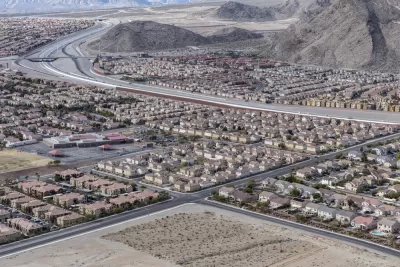Yes, sprawl is still bad for the environment.

As Americans have moved to automobile-dependent suburbs, vehicle travel has exploded. So as a matter of common sense, it might seem obvious that more sprawl equals more pollution.
This view is backed up by a study conducted by Harvard economist Edward Glaeser and UCLA economist Matthew Kahn [pdf], which found that the least automobile-dependent regions emitted fewer greenhouse gases than other large metropolitan regions. In particular, New York City, the most transit-oriented region in the United States, had the lowest level of automobile-related carbon dioxide emissions among 66 regions surveyed. The five other regions where over ten percent of commuters used public transit (Washington, Chicago, Boston, Philadelphia, San Francisco) also emitted less carbon dioxide than the national median. By contrast, auto-oriented regions such as Memphis had higher-than-average emissions. Moreover, cities consistently created less carbon dioxide than suburbs: in every single one of 66 cities surveyed, transportation-related carbon dioxide emissions (including both emissions from automobiles and emissions from transit) were higher in suburbs than in cities.
Environmental benefits from walkable development are not limited to greenhouse gases. One study by several scholars found if vehicle miles traveled in the 11 largest Midwestern regions decreased by ten percent, the resulting decline in particulate matter pollution would lead to 525 fewer pollution-related deaths and an even larger reduction in the number of hospital admissions.
Nevertheless, some commentators argue that density means pollution. For example, Joel Kotkin writes: "proximity to busy roads, high-traffic density, and increased exposure to pollution are linked to a variety of respiratory ailments." However, the suburban sprawl that Kotkin champions is the cause of urban air pollution, not a remedy. When Americans move into car-dependent suburbs, they are more likely to drive to cities, which makes those cities more polluted. The fewer suburbs, the fewer cars; the fewer cars, the less pollution.
A related argument is that compact development creates traffic congestion, which in turn increases emissions. But if this argument supported suburbanization, congestion-related fuel consumption would have decreased as low-density suburbia grew. This failed to occur: since 1982, the amount of fuel wasted due to American traffic congestion grew from four gallons per driver to 19. Moreover, congestion increased not only in regions with growing central cities, but in rapidly decentralizing regions. For example, St. Louis lost 30 percent of its central city population between 1980 and 2014, but the amount of lost fuel lost per driver more than quadrupled. And Buffalo lost about a quarter of its central city population between 1980 and 2014—yet its congestion-related wasted fuel per driver also more than quadrupled (all relevant data is included in the Texas Transportation Institute's latest Urban Mobility study). And if density-related congestion increased emissions, urban places would generate more transportation-related greenhouse gases than their suburbs—which, as noted above, is not the case.
Another anti-urban argument is that because of the energy used in constructing apartment buildings (especially high-rise buildings) urban areas in fact are more carbon-intensive. For example, Kotkin cites a document by an Australian Conservation Foundation [pdf] stating that inner cities have higher environmental impacts than suburbs or rural areas. However, the study goes on to state that the reason for this was that "the opportunities for relatively efficient, compact living appear to be overwhelmed by the energy and water demands of modern urban living, such as air conditioning, spa baths, down lighting and luxury electronics and appliances… These trends in are closely correlated with wealth. Higher incomes in the inner cities are associated with higher levels of consumption across the board." In other words, Australian cities are more carbon-intensive than their suburbs not because of the evils of density, but because those cities are richer and thus buy and use more goods. In fact, the Foundation has rejected the use of its report to defend sprawl, stating, "Eco-footprints in suburban areas in Australia are lower than in the urban core in spite of, not because of, lower residential densities."

Study: Maui’s Plan to Convert Vacation Rentals to Long-Term Housing Could Cause Nearly $1 Billion Economic Loss
The plan would reduce visitor accommodation by 25,% resulting in 1,900 jobs lost.

North Texas Transit Leaders Tout Benefits of TOD for Growing Region
At a summit focused on transit-oriented development, policymakers discussed how North Texas’ expanded light rail system can serve as a tool for economic growth.

Why Should We Subsidize Public Transportation?
Many public transit agencies face financial stress due to rising costs, declining fare revenue, and declining subsidies. Transit advocates must provide a strong business case for increasing public transit funding.

How to Make US Trains Faster
Changes to boarding platforms and a switch to electric trains could improve U.S. passenger rail service without the added cost of high-speed rail.

Columbia’s Revitalized ‘Loop’ Is a Hub for Local Entrepreneurs
A focus on small businesses is helping a commercial corridor in Columbia, Missouri thrive.

Invasive Insect Threatens Minnesota’s Ash Forests
The Emerald Ash Borer is a rapidly spreading invasive pest threatening Minnesota’s ash trees, and homeowners are encouraged to plant diverse replacement species, avoid moving ash firewood, and monitor for signs of infestation.
Urban Design for Planners 1: Software Tools
This six-course series explores essential urban design concepts using open source software and equips planners with the tools they need to participate fully in the urban design process.
Planning for Universal Design
Learn the tools for implementing Universal Design in planning regulations.
City of Santa Clarita
Ascent Environmental
Institute for Housing and Urban Development Studies (IHS)
City of Grandview
Harvard GSD Executive Education
Toledo-Lucas County Plan Commissions
Salt Lake City
NYU Wagner Graduate School of Public Service



























